
a web page by Don Roberson |
SCREAMERS Anhimidae |
|
Perhaps the most impressive of the Anhimidae is Horned Screamer (left) of the Amazon basin and related lowlands. These are huge, impressive goose-like birds in a monotypic genus. They have a pronounced 'horn' atop the head in both sexes (an unmodified, unbranched feather shaft); a hooked bill on a disproportionately small head; and vestigial webbing between the front toes. We found this Horned Screamer among a small group on a black-water oxbow lake, left behind after changes in the main river channel, in Amazonian Basin of southeastern Peru. The two other screamers (Northern and Southern) are similar to each other and assigned to genus Chauna. All screamers are birds of extensive swampy wetlands. This pair of Southern Screamer (below), perched on a tall flat-topped, river-edge tree in the Brazilian Pantanal, can see nothing but swampy wetlands in all directions. |
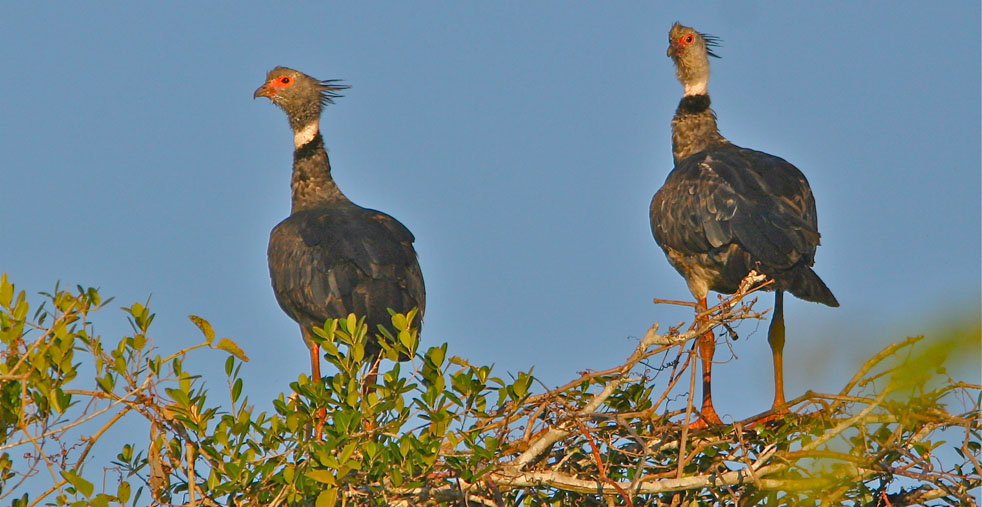 |
Although they are goose-like, numerous anatomical differences make them distinctive: the lack feather tracks so their feathers grow evenly all over the body; they have bony wing spurs; and their bones are far more pneumatic than other birds. This makes their bone structure very lightweight. Further, they have a complicated system of air-sacs beneath the skin which, when contracted, can collapse rapidly with a distinctive cracking sound (Carboneres 1992). Screamers tend to mate for life — or at least for several years in a row — and they may breed at any time of the year. The two Chauna screamers hold territories as pairs. However, when they are not breeding, screamers can form huge flocks and move locally and erratically in response to water conditions. Some flocks may have thousands of birds. |
Southern Screamer (photos left and below) occurs from Bolivia and east to Mato Grosso and Rio Grande do Sul, Brazil, and south to northern Argentina. Northern Screamer Chauna chavaria has a limited range in marshes of northern Colombia and northwestern Venezuela. It resembles Southern Screamer but has a much thicker black neck band. Both Chauna screamers often roost in trees, and some proclaim their territory in strident voices from treetop (Southern Screamer pair, below). These huge, odd birds are very appropriately relegated to hot, muggy, swampland. It takes big swamps to provide habitat for these wilderness icons. |
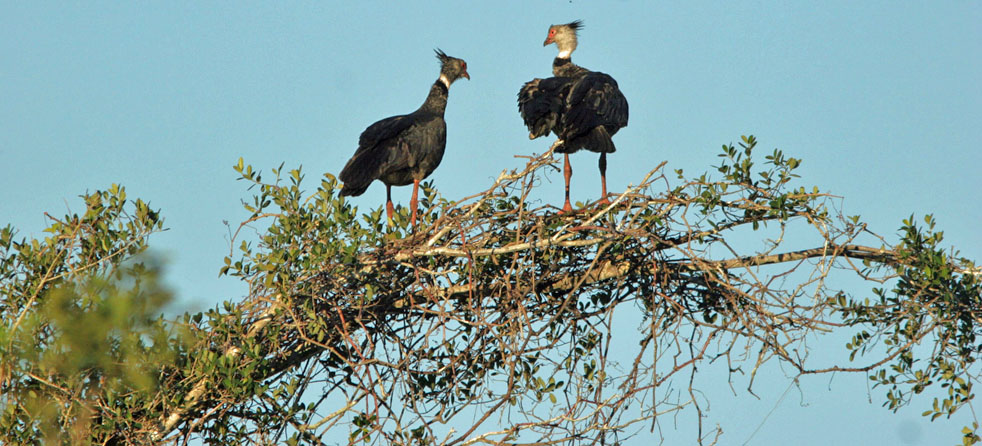 |
Photos: The Horned Screamer Anhima cornuta was photographed from a canoe on Cocachoca, Tambopata Nature Reserve, Madre de Dios, Peru, in July 1987. All the photos of Southern Screamer Chauna torquata were taken along the Rio Cuiba, in Brazilian Pantanal, on 20 July 2010, except the beach-walking bird photographed along a tributary the next day. All photos © Don Roberson; all rights reserved. Bibliographic note: There is no family book but this group is covered in standard waterfowl texts, and Carboneres (1992) provides a nice introduction with some fine photos. Literature cited:
|
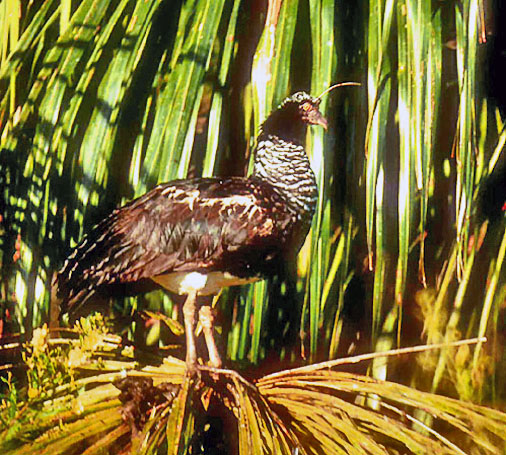 The Anhimidae are a small family of three Neotropical waterfowl — called Screamers, and assigned to two genera — that are placed in the Anseriformes with ducks, geese, and swans. They have long been a fmaily separated from typical waterfowl. More recently, genetic work elevated Magpie-Goose of Australia to family status (e.g., Sibley & Ahlquist 1990), providing a monotypic family in the Ansseriformes.
The Anhimidae are a small family of three Neotropical waterfowl — called Screamers, and assigned to two genera — that are placed in the Anseriformes with ducks, geese, and swans. They have long been a fmaily separated from typical waterfowl. More recently, genetic work elevated Magpie-Goose of Australia to family status (e.g., Sibley & Ahlquist 1990), providing a monotypic family in the Ansseriformes.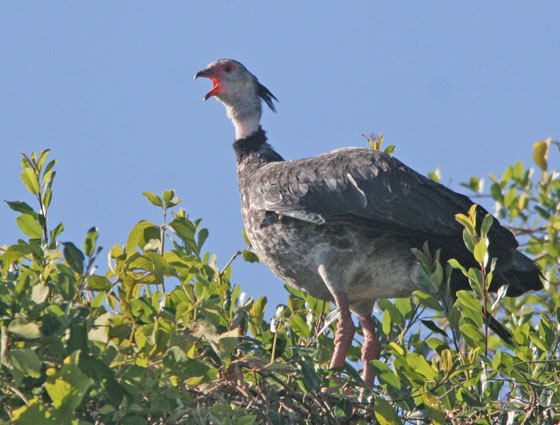 Screamers can be very vocal. The vernacular name comes from these vocalizations which are extremely loud and obnoxious. The notes are not melodic and yet the calls are extremely loud and can be given for hours on end. It is said that when a group is rising from a swamp and calling, the noise can be deafening. They can give trumpeting notes; one local name for Southern Screamer (right) is "tacha" or "dhajá" from its double-noted trumpeting call (Carboneres 1992).
Screamers can be very vocal. The vernacular name comes from these vocalizations which are extremely loud and obnoxious. The notes are not melodic and yet the calls are extremely loud and can be given for hours on end. It is said that when a group is rising from a swamp and calling, the noise can be deafening. They can give trumpeting notes; one local name for Southern Screamer (right) is "tacha" or "dhajá" from its double-noted trumpeting call (Carboneres 1992). 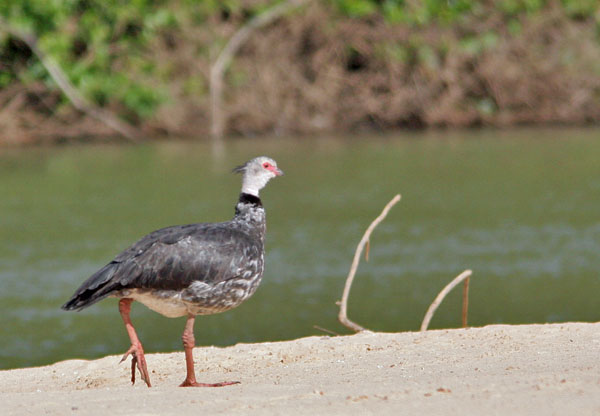 Screamers are entirely herbivorous. They eat a variety of aquatic plants, including flowers, seeds, and roots. The tongue is horny, rather than fleshy, to deal with tough plants. They can fly well — with necks outstretched like storks — but are ponderous in taking off. The only ones I've seen on the ground have been walking on sandy river-edge beaches (left). They have an erectile crest on the rear crown that is usually recumbent (see below). Sexes are said to be similar.
Screamers are entirely herbivorous. They eat a variety of aquatic plants, including flowers, seeds, and roots. The tongue is horny, rather than fleshy, to deal with tough plants. They can fly well — with necks outstretched like storks — but are ponderous in taking off. The only ones I've seen on the ground have been walking on sandy river-edge beaches (left). They have an erectile crest on the rear crown that is usually recumbent (see below). Sexes are said to be similar.